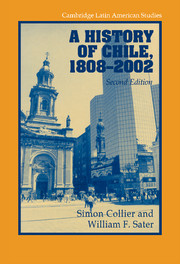Book contents
- Frontmatter
- Contents
- List of maps
- Preface to the Second Edition
- A note on geography
- CAMBRIDGE LATIN AMERICAN STUDIES
- PART I Birth of a nation-state, 1800s–1830s
- PART II The rise of a republic, 1830s–1880s
- PART III The nitrate era, 1880s–1930s
- PART IV Industrial advance and the dawn of mass politics, 1930s–1960s
- PART V Democracy and dictatorship, 1960s–2000s
- Glossary of Spanish terms
- Initials and acronyms
- Further reading
- Index
PART III - The nitrate era, 1880s–1930s
Published online by Cambridge University Press: 05 June 2012
- Frontmatter
- Contents
- List of maps
- Preface to the Second Edition
- A note on geography
- CAMBRIDGE LATIN AMERICAN STUDIES
- PART I Birth of a nation-state, 1800s–1830s
- PART II The rise of a republic, 1830s–1880s
- PART III The nitrate era, 1880s–1930s
- PART IV Industrial advance and the dawn of mass politics, 1930s–1960s
- PART V Democracy and dictatorship, 1960s–2000s
- Glossary of Spanish terms
- Initials and acronyms
- Further reading
- Index
Summary
Victory in the War of the Pacific was followed at home by the triumph of “parliamentary” ideas over presidentialism in the civil war of 1891. Underlying the politics of the next three decades was a cycle of renewed export-led growth on the strength of the trade in nitrates, accompanied by inevitable social diversification, the main symptoms of which were an emergent (if still small) middle class and a militant labor movement. The so-called Parliamentary Republic failed to address the new social dilemmas of the period (Chapter 7). Failure also marked the first, would-be reforming presidency of the charismatic Arturo Alessandri. Between 1924 and 1932 the country experienced both military intervention and authoritarian rule, which had the effect of somewhat diminishing oligarchic predominance in politics. In the 1930s, Alessandri restored the Chilean tradition of institutional continuity, but in a changed political landscape. Export-led growth, meanwhile, was halted by the rise of synthetic nitrates after World War I and by the Depression of the 1930s, which prompted greater state intervention in the economy (Chapter 8).
- Type
- Chapter
- Information
- A History of Chile, 1808–2002 , pp. 147 - 148Publisher: Cambridge University PressPrint publication year: 2004



